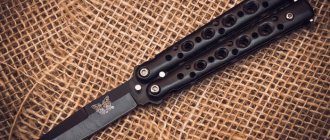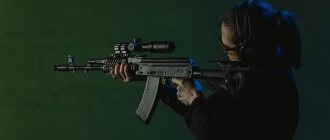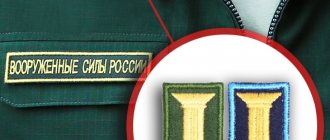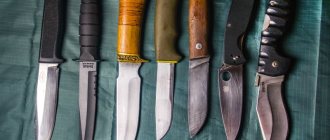Balisong, or butterfly knife, belongs to knives of a special design, namely: hinged-frame. It has a rather interesting history, as well as wide distribution in the world and unusual areas of application. It became widespread after the Second World War. Possession of this knife was considered prestigious by the hooligans themselves, and the quality of the knife was not taken into account at all, the main thing was dexterity in handling. It was because of this knife that a special culture emerged - flipping. This is a masterly rotation, throwing and tossing of a “butterfly”. A person with these skills can literally hypnotize the viewer with balisong tricks. Flipping lovers themselves talk about its relaxing properties.
Balisong butterfly knife.
"RoboCop 2"
An urban universal model with one of the best designs. The blade is made of tool steel used in heavy metallurgy. The steel is made in the USA.
It has excellent characteristics, durable, wear-resistant. The strength of the material allows the knife to be used for a wide variety of jobs. The steel is chrome plated and does not rust, which is why the product can be used in both hot and cold climates.
What is a butterfly knife?
When wielding a balisong masterfully, the movement of the two halves of the handle when opened resembles the flapping of the wings of a butterfly. This is where the name of the knife comes from.
The butterfly knife has an unusual design. The handle consists of 2 halves, which are held together with a latch. When folded, the blade is hidden there. To expose the blade, you need to open the halves of the handles.
Different materials are used to make balisongs. The blade is usually made of steel of different grades. Traditionally, the halves of the handles were made from buffalo horn. Nowadays they are most often made of metal, hardwood or impact-resistant plastic.
Butterfly knives are classified according to size:
- large (up to 29 cm when opened);
- medium (up to 24 cm);
- small (up to 19 cm);
- ultra-small or souvenir (up to 9 cm).
This model is valued for its simplicity and reliability of design. It allows you to open and close the knife with one hand. At the same time, in the open position the blade is securely fixed. Hiding the blade in the handle when closed allows for double-sided sharpening.
"Pinocchio"
The balisong of this model is simple and reliable. Easily, effortlessly opens and closes with one hand.
The product does not open on its own. Both parts are made of good steel, durable, and additionally treated against corrosion. A universal model that can be used in the city, as a tool that you can take with you on a hike.
Spreading the knife around the world
The blade became widespread after the Second World War. And soon after, Hollywood armed street thugs with the balisong in its films. Thanks to cinema, the “butterfly” gained worldwide fame. It is believed that Asians actively exploit this beautiful legend to sell balisongs to tourists.
But despite this, Filipinos use knives in different areas. Fishermen cut their ropes during a storm, peasants use them in everyday life. If the need arises, it instantly turns into a weapon of defense.
Despite its criminal reputation, products of this design are still produced by many global companies.
T700
Stylish model produced by the Chinese company Pirat. You can think of it as a tool for learning how to flip. For the blade, ordinary stainless steel 40X13 is used, this is a simple but popular brand. The material does not rust and resists the formation of stains, which makes the knife undemanding to maintain and easy to care for. The product is suitable for throwing. The blade is sharpened as standard; the butt has wooden decorative overlays.
Top 10 best butterfly knives in the table
The ranking includes the 10 best-selling and most popular butterfly knives among buyers.
| Name | Characteristic | price, rub. |
| Master K | A classic-shaped butterfly knife made entirely of metal. Easily folds and unfolds with one hand. It has a blade 7.5 cm long. Holes on the handle provide a more reliable grip on the palm. | 350 |
| zQz TryZoom | A training model with an unusual gradient color, made of stainless steel. The blade is 10 cm long with a rounded tip and is not sharpened. The knife blade is lightweight due to round holes. | 550 |
| Pirate | A classic butterfly knife for everyday use. Made of stainless steel grade 40X13. It has a blade 7.8 cm long with a straight sharpening. | 690 |
| Startfall Standoff 2 v2 | A souvenir knife that completely replicates the design of its in-game counterpart from Standoff 2. It is made of wood, so it is completely safe and suitable for performing tricks. The knife is painted and varnished on top. | 550 |
| CS GO | A butterfly knife that fans of the game Counter-Strike: Global Offensive will appreciate. Made from high quality plywood. Fastening is carried out with bolts. Absolutely safe, can be used by children. Suitable for performing tricks. | 350 |
| Nozhemir Clear layout Strike B-113CS | A classic butterfly knife with an iridescent titanium nitride color. It not only performs a decorative function, but also protects the blade from corrosion and minor damage. Made of 440 steel. The wide blade, 8.2 cm long, allows the knife to be used not only for flipping, but also in real hiking conditions. The rear handle has a clip for fastening. | 990 |
| Nozhemir 777 B-122 | Tourist butterfly knife in an unusual rainbow color. Made from 440A stainless steel. The blade is made in a bowie silhouette and has a slightly raised tip. Relief stripes on the handle prevent the knife from slipping out of your hands during operation. The blade length is 8.3 cm. | 460 |
| "Mantis" | A butterfly knife from a Russian brand with a memorable original design. The length of the blade is 8.9 cm. Thanks to the all-metal construction, it will last for a long time. The knife is made of 400C stainless steel. Suitable for solving everyday problems. | 1100 |
| "Violet" | The unusual purple color of the knife attracts attention. The model is made of 3CR13 steel. It has a blade 7 cm long. The handle of the knife is decorated with decorative patterns. | 850 |
| Dragon glass Standoff | A souvenir knife made of wood, the design of which follows the design of a knife from the popular computer game Dragon glass Standoff. The blade is dull, so it cannot hurt you. | 560 |
T704
One of the models manufactured by the Chinese company Pirat. Refers to edged weapons, there is a certificate, you can freely store and carry it. Designed for household purposes and for use as a sports tool. The blade is made of durable, unbreakable steel. The handle is also made of metal. The color of the knife is light gray, the coloring gives it originality. The color of the model differs from most others. The handle is decorated with figured cutouts.
Methods of application
Absolutely all knife models are suitable for everyday needs. They are durable. The only thing that is required is lubrication of the hinges. Many of us are sure that the butterfly knife has only one area of application - criminal. Looking at the “butterflies” in the hands of bandits from television series, we are even more convinced of the exceptional combat qualities of this weapon.
However, the balisong is effective only at the moment of rotation. The knife itself has a thin handle, without a stop. When jabbed, fingers can slide onto the blade, thereby injuring them. A regular knife with a folding and fixed blade will be much more convenient than the advertised “butterfly”.
Balisong is not intended for household use either. Of course, they can cut food, but for a person long-term use of such a knife will result in calluses.
Application in military affairs
Balisong designs are widely used in military affairs. They are distinguished by high-quality steel and precise machining using technological alloys. Blueclass series models:
32 Morpho
Characteristics of balisong 32 Morpho from the Blueclass series.
42 Bali-Song
Characteristics of the butterfly 42 Bali Song from “Benchmade” of the “Blueclass” series.
Werewolf 2
The “Werewolf 2” balisong model was developed by Russian designer I. Skrylev. Its presentation took place in the early 1990s at the “Rescue Means 1994” exhibition.
The model of the knife was of interest to representatives of law enforcement agencies and intelligence agencies. Subsequently, this balisong design was adopted by the special forces of the Ministry of Internal Affairs, the army and special services as an army survival knife.
A unique invention of the balisong "Werewolf 2".
Knives have always played a supporting role in warfare. The design of his knife depended only on the soldier’s main weapon. Over time, the importance of knives as military weapons has decreased significantly. Knives have become universal tools in the fight for survival.
Balisongs are also being developed with different sets of instruments. The blades in this design are connected to a steel plate, which allows them to be used as a multifunctional tool.
In Russia there is one that produces butterflies. The Skat M knife is a hinged frame balisong weighing only 56 grams. This is a universal model for everyday life and hiking.
"Sekiro-02"
Tactical butterfly knife. The steel used for the blade and handle is of high strength and hardness. Balisong weighs a little, despite its medium size. The black color of the product and the strict but attractive design make it popular among buyers.
Balisong knives are undoubtedly designed to be comfortable, versatile and eye-catching. Butterflies are convenient to use in everyday life; you can carry them with you outdoors or use them for protection. Because the knives fold easily, they do not take up much space. You can carry “butterflies” in your pocket, bag, backpack.
Story
The origin of this item is currently unclear. There is a beautiful, mythological story about its Filipino origins. Allegedly, the idea of such a knife originated in the Philippines.
Oral histories claim that blades were first created in the Philippines in 800 AD. e. The meaning of the balisong in this story is quite symbolic: one part of its handle personified the sky, the second, respectively, the earth, and the blade was the surface of water between them.
According to legend, the balisong was a sacred artifact that was passed down from generation to generation in the fishing community. However, there are no documents or archaeological evidence to support this.
Mass production of Balisong in the Philippines can only be attested to in the early 1900s. In the tales of the indigenous inhabitants of the islands, only the traditional “Bolo” knife was mentioned. There are no traces in folklore that would lead to the appearance of balisongs there.
However, Filipinos believe in the archaic origins of the blade. That’s why they gave it the name “balisong”. In Old Tagalog it means "broken horn" or "thundering horn". It is quite possible to interpret the legend, which says that the handles of the first blades were made of horn, but what else? In addition, there are corresponding toponyms in the Philippines, so why shouldn’t the “butterfly” appear there?
The master makes blades by hand.
But this is all guesswork. The word “balisong” was first recorded in writing in 1905. Just then, the production of butterfly knives was organized in the port city of Batangas. The total length of the product, including the blade and handle, was 29 centimeters. The pioneer manufacturer was the blacksmith Perfecto de Leon. His balisong differed little from the modern example.
The European version of the origin of the balisong is less poetic. Following her, this knife was born from the union of a folding ruler and an ordinary knife.
Some written sources document the origin of the “butterfly”. For example, French shipbuilders used the “pied de roux” measuring device in their work, the design of which was exactly that: a combination of a knife and two parts of a ruler.
One copy, as proof, still exists. It dates from 1791. This became the starting point for the emergence of the patented production of these blades.
In the 19th century, a manufacturing company of Anglo-German origin attempted to put balisong production on stream, but due to design defects this business plan failed.
In 1988, it was founded and registered the “Ball-song” brand. The company currently occupies a leading position in the production of folding butterfly knives.
Benchmade company logo.
The peak of attention to the balisong occurred at the end of World War II. This interest is due to American soldiers who brought similar devices home with them, calling them “click-click knives.” Some of these soldiers, having never found their place outside of hostilities, were engaged in illegal activities.
Thanks to the criminal underworld of that time, the butterfly knife became firmly established in criminal fame. Later, some revived martial arts contributed to the spread of interest in balisong. Hollywood should also be mentioned. Thanks to the action heroes of the 1970s and 1980s, they masterfully wielded the balisong, killing their opponents.
Other uses of the term
During the Spanish-American and Philippine-American Wars, the term "to bolo" (for failing a test, examination or discipline) appeared in the slang of the US military, which arose from the time of the joint Philippine-American military forces, (which recruited, among others, and conscripted partisans). Those local soldiers and guerrillas who were unable to demonstrate skill in marksmanship were issued bolos instead of firearms, so that unskilled fighters would not waste their already scarce ammunition.
During the Vietnam War, 8th Fighter Wing commander Robin Olds developed the plan "Operation Bolo" to lure North Vietnamese MiG-21 fighters into a dogfight against US Air Force F-4 Phantom II fighters. It was a plan based on deception, in which the F-4s behaved like the relatively safe F-105 fighter-bombers. When the MiG pilots figured out the situation, it was already too late; they found themselves in a trap from which there was nowhere to retreat. The name of the operation comes from the bolo knife. Today, Operation Bolo is considered one of the most successful ploys in air combat.
Historical meaning
The bolo was the main weapon of the Katipunan (Society of the Sons of the Nation) during the Philippine Revolution. Similar knives were also used by Filipino guerrillas during the Philippine-American War.
During World War I, US Army soldier Henry Johnson gained international fame by repelling a German raid in hand-to-hand combat using a bolo knife.
During World War II, the first Philippine regiment was called the "Bolo Battalion" and its soldiers used bolos for hand-to-hand combat.
On December 7, 1972, would-be assassin Carlito Dimahilig used a bolo to attack former First Lady Imelda Marcos as she appeared on stage during a live awards show. Dimahilig tried to punch Marcos in the stomach several times, but she defended herself from the punches. The terrorist was shot dead by security forces and the First Lady was taken to hospital.
Model selection and purchase
The butterfly knife itself is not a bladed weapon. Purchasing and wearing is not prohibited by the legislation of the Russian Federation, which means you can easily find a model that will meet all your needs and selection criteria. As a rule, you cannot find worthwhile copies in ordinary stores; most often they are souvenirs. You can contact specialized weapons stores or online stores.
Even on AliExpress there are quite interesting models, the only negative is the raw materials used for production. That is, the practical qualities of such a knife may tend to zero, but it is beautiful and well-balanced, just what you need for flipping, and it’s also inexpensive. The types differ in design and specialization. The blade itself can be straight or wavy, with varying degrees of sharpening. First of all, they are divided by size:
- Large - 24-28 centimeters;
- Average - 19-24 centimeters;
- Small - 9-19 centimeters;
- Ultra-small - up to 9 centimeters (blade length less than 4 centimeters).
The attitude of the law to this knife
In famous countries such as:
- Great Britain.
- Switzerland
- Germany.
- Australia.
- Canada.
- Hong Kong.
- Philippines.
- USA, in some states.
- Russia.
Wearing, using, or storing balisong is prohibited by law or a special permit is issued.
Due to the spread of terrorist and extremist groups, many countries have their own measures to limit the use of these types of knives.
To avoid various sanctions for the production of butterfly knives, many manufacturing companies have moved to Southeast Asia.
If the blade of a knife reaches 20 cm, then it is classified as a full-fledged edged weapon.
Those models that are available in stores are made with a blade no more than 9 cm, with small handles that do not provide support for the fingers, and this excludes them from the range of effective military weapons.
But when a knife is used for self-defense, it combines striking and blade properties. This measures the influence on the attacker, taking into account the current situation, the transition from a shock-painful technique with a folded device or the application of piercing, cutting blows with an unfolded knife.
And this, according to the law, is qualified as an excess of self-defense and threatens with a real sentence.
Therefore, when purchasing such a knife, be guided by the law; ignorance of the law does not excuse you from answering.
Techniques and figures
In order to open a butterfly knife spectacularly and beautifully, there are several methods, but the first and simplest is basic vertical opening (“basic, vertical opening”). As a rule, the trick begins with a closed knife and ends with its opening; the order of actions can change at your discretion. One famous figure is "Charlie Chaplin" - this is the rotation of a knife in its half-open position using several or all fingers of one hand. Various manipulations are also popular, after which it remains open or closed.
You can hold it with a regular or reverse grip, with your hand or with just two fingers. The choice can affect the entertainment value of the performance. The ability to handle any knife beautifully and effectively is a special culture. Flipping, for example, develops a huge number of necessary and very useful characteristics:
- Agility;
- Attentiveness;
- Finger strength;
- Coordination.
This discipline is similar to juggling, a very eccentric form of it. You can choose a very beautiful “equipment” for practicing with a design and an inlaid handle; after just a few training sessions, the attention of a crowd of onlookers is guaranteed.
Types of bolos
Different types of bolos are used for different purposes:
- Multi-purpose bolo: used for all types of necessary work, such as opening coconuts.
- Kharash: Looks like a small scythe, used for cutting tall grass. The Mindanao people call this knife "lampas".
- Cutsilyo: The term comes from the Spanish word "cuchillo" ("knife"). Commonly used for slaughtering pigs, bleeding after slaughter and cutting carcasses.
- Small bolo.
- Bolo-gun (or simply gun): a bolo of a specific shape for digging up roots and weeding.
- Garab: Used for harvesting rice.
- Large pinuti: traditionally, this knife is used to milk out the venom of snakes, spiders or scorpions, and is also used for self-defense.
- Sundang (also "bolo tip" or "so"): Primarily used for cutting coconuts. The sundang was a popular weapon of the Filipino revolutionary scavengers who fought against the Spanish Empire and during the subsequent Philippine-American War.











